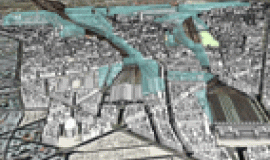
The coming into service of the TGV Est on June 10, 2007, marks a new phase in the development of the Gare du Nord and Gare de l’Est district, which started with the introduction of high-speed trains at the beginning of the 90s. This study sheds light on the conditions under which these two large metropolitan facilities, the Gare du Nord and the Gare de l’Est, co-exist with a section of the city where people live and work, in a context of rapid and far-reaching changes.
Firstly, a historical analysis has revealed which features of the territory form its specific character, notably two Parisian hospital units and two of the six mainline stations in Paris. It was also an opportunity to look at recent changes in another time frame. Secondly, the strategic importance of the central position of this area is discussed, a position strengthened even further by the arrival of the TGV Est which, together with the development of the high-speed network, has resulted in this district finding itself less than 4 hours from the centre of several European metropolises such as Frankfurt (570km), Amsterdam (500km), Brussels (300km) and London (450km).
At the same time, this area of the city remains a separate entity with 28,000 inhabitants and 32,000 jobs. Therefore, the main issue is how to integrate the local area with the functions of the metropolis. Projects already completed or planned are following this lead of bringing some order to the area, e.g. the redevelopment of the Boulevard de Magenta and the areas surrounding the stations and the installation of a “two-hub” connection.
This study is not available online but can be consulted by appointment via the Documentation Service



